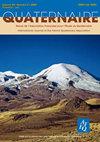葡萄牙Gruta da Aroeira中更新世遗址的蓖麻纤维化石与人与海狸的相互作用
IF 0.7
4区 地球科学
Q4 GEOSCIENCES, MULTIDISCIPLINARY
引用次数: 6
摘要
在这里,我们分析了来自葡萄牙塔古斯盆地(Torres Novas) Almonda岩溶系统Gruta da Aroeira中更新世遗址的蓖麻纤维化石遗骸,并讨论了该地区海狸存在的考古意义。Almonda喀斯特系统一直是葡萄牙人类进化的背景,因为从中更新世到全新世,这里有不同的地点,不同的时代,既有人族化石遗迹,也有动物和考古遗迹。在喀斯特系统的至少三个洞穴的考古沉积物中发现了海狸化石:古鲁塔·达·阿罗埃拉,古鲁塔·达·奥利韦拉和古鲁塔·达·西斯特纳洞穴。在这里,我们首次描述了来自Gruta da Aroeira的蓖麻纤维化石。在Aroeira发现的海狸非常引人注目,因为它们是欧洲最西端的蓖麻纤维化石记录,可追溯到海洋同位素阶段(MIS) 11,大约420 ka。本文的目的有两方面:一是研究Aroeira地区的海狸化石,二是探讨Almonda喀斯特遗址中海狸存在的古生态和古环境意义。这使我们能够讨论人类与海狸的相互作用。本文章由计算机程序翻译,如有差异,请以英文原文为准。
The fossils of castor fiber from the middle Pleistocene site of Gruta da Aroeira (Portugal) and human-beaver interaction
Here we analyze the fossil remains of Castor fiber from the Middle Pleistocene site of Gruta da Aroeira, in the Almonda karst system, Tagus basin (Torres Novas, Portugal) and discuss the archaeological implications of the presence of beavers in the region. The Almonda karst system has been the backdrop for human evolution in Portugal, because there are different localities, of different ages, from the Middle Pleistocene to the Holocene, with fossil remains of hominins as well as faunal and archaeological remains. Beaver fossils have been found in the archaeological deposits of at least three cavities of the karst system: the Gruta da Aroeira, the Gruta da Oliveira and the Galeria da Cisterna. Here, for the first time, we describe the fossils of Castor fiber from Gruta da Aroeira. The beavers from Aroeira are remarkable because they are the westernmost fossil record of Castor fiber in Europe dated to Marine Isotope Stage (MIS) 11, around 420 ka. The aim of the present article is twofold, firstly to study the fossils of beavers from the Aroeira locality, and secondly to discuss the palaeoecological and palaeoenvironmental implications of the presence of this rodent in the Almonda karst sites. This allows us to discuss the hominin-beaver interactions.
求助全文
通过发布文献求助,成功后即可免费获取论文全文。
去求助
来源期刊

Quaternaire
地学-地球科学综合
CiteScore
1.70
自引率
0.00%
发文量
18
审稿时长
>12 weeks
期刊介绍:
La revue Quaternaire créée dès 1964 par l"AFEQ sous le nom de Bulletin de l"AFEQ est devenue Quaternaire en 1990. Ce journal scientifique paraît au rythme de quatre numéros par an. La revue publie des numéros d"auteurs (par ordre d"arrivée des manuscrits après acceptation) ou des numéros thématiques sur proposition ou invitation par le comité de rédaction. Les articles (en langue française, anglaise ou allemande) traitant de tous les aspects du Quaternaire sont acceptés. La revue est publiée avec le concours du Centre National de la Recherche Scientifique.
 求助内容:
求助内容: 应助结果提醒方式:
应助结果提醒方式:


